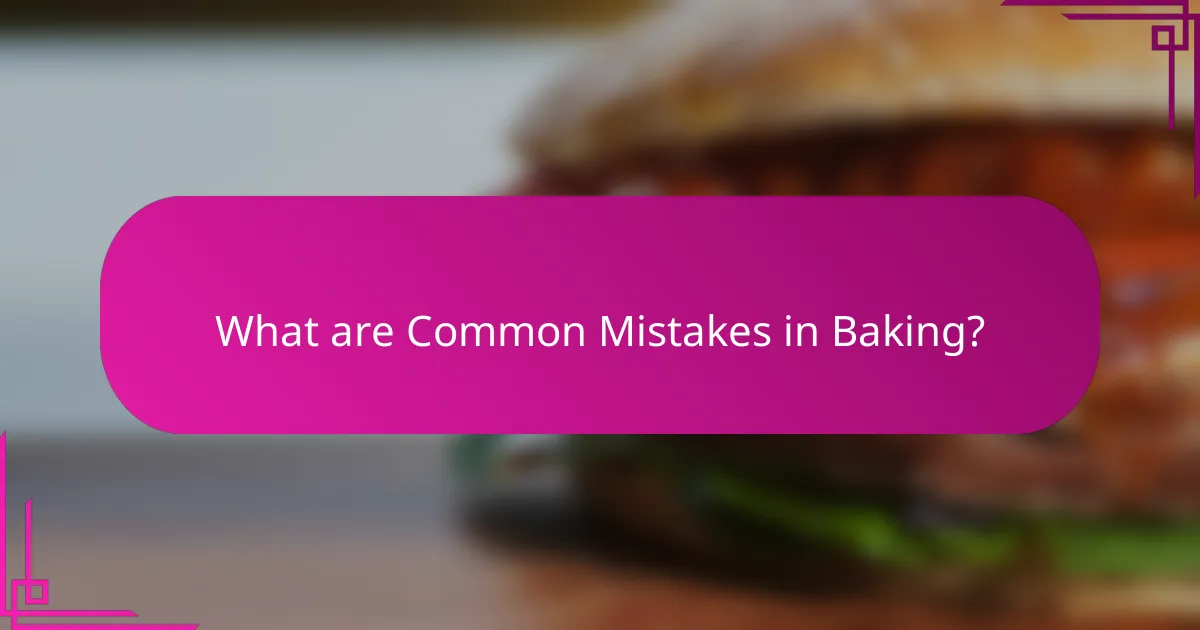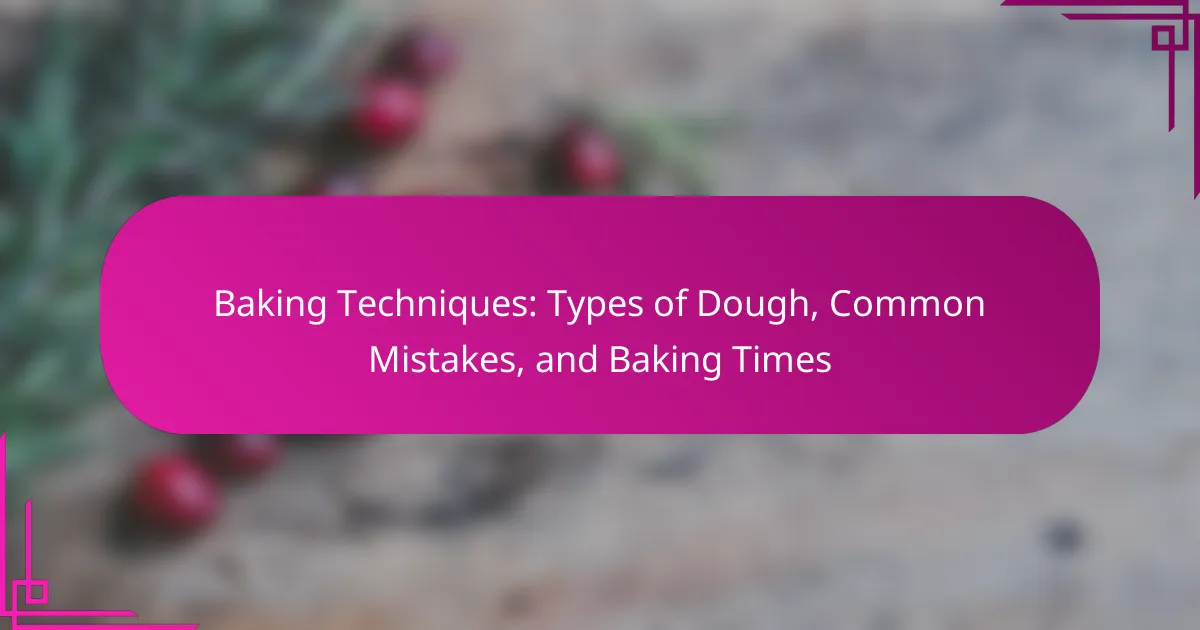Baking techniques encompass the methods used to prepare and cook various baked goods, including mixing, kneading, proofing, and baking, each influencing the final product’s texture and flavor. Different types of dough, such as bread, pastry, pizza, and cookie dough, serve specific purposes in baking, impacting the overall outcome. Common mistakes in baking, such as inaccurate measurements and incorrect oven temperatures, can lead to undesirable results, while recommended baking times vary by recipe type to ensure proper cooking. Understanding these elements is essential for achieving consistent and delicious baked goods.

What are Baking Techniques?
Baking techniques are methods used to prepare and cook baked goods. These techniques include mixing, kneading, proofing, and baking. Each method affects the texture and flavor of the final product. For example, kneading develops gluten, which provides structure. Proofing allows yeast to ferment, creating air pockets. Different baked goods require specific techniques for optimal results. Mastery of these techniques leads to consistent and delicious outcomes in baking.
How do different baking techniques impact the final product?
Different baking techniques significantly influence the texture, flavor, and appearance of the final product. For instance, methods like creaming butter and sugar create a light, airy texture in cakes. This technique incorporates air, which expands during baking, resulting in a fluffy structure. Conversely, techniques like kneading dough develop gluten, leading to a chewy texture in bread.
The temperature at which items are baked also affects outcomes. Baking at a high temperature can create a crispy crust, while lower temperatures often yield a softer result. Additionally, the use of steam during baking can enhance the rise and crust of items like bread.
Using different pans can alter heat distribution. Metal pans conduct heat better than glass, affecting browning and cooking time. Each technique has a unique impact, making it crucial to select the right method for desired results.
What are the key factors in choosing a baking technique?
Key factors in choosing a baking technique include the type of dough, desired texture, and baking time. The type of dough determines the appropriate technique; for example, yeast dough requires proofing, while pastry dough needs a gentle touch. Desired texture influences the choice; for instance, a crispy crust may require high heat, while a soft interior benefits from lower temperatures. Baking time is crucial; overbaking can lead to dryness, while underbaking may result in a raw center. Understanding these factors ensures successful baking outcomes.
How do baking techniques vary across different cuisines?
Baking techniques vary significantly across different cuisines. Each cuisine employs unique methods that reflect cultural preferences and ingredient availability. For example, French baking often emphasizes techniques like laminating dough for croissants. Italian baking focuses on using high hydration dough for pizza and focaccia. In contrast, Middle Eastern baking includes techniques such as using semolina for various breads. Asian cuisines may utilize steaming as a primary method, seen in bao and dumplings. These variations illustrate how regional ingredients and traditions shape baking practices globally.
Why are baking techniques essential for successful baking?
Baking techniques are essential for successful baking because they ensure consistent results and optimal flavor. Proper techniques help control the chemical reactions that occur during baking. For example, accurate measurements of ingredients lead to the desired texture and rise. Techniques like kneading develop gluten, which provides structure to bread. Additionally, understanding oven temperatures affects browning and cooking times. Using the right technique can prevent common mistakes, such as overmixing, which can result in dense baked goods. Mastering these techniques ultimately enhances the quality of the final product.
What role do baking techniques play in texture and flavor?
Baking techniques significantly influence the texture and flavor of baked goods. Techniques such as mixing, kneading, and baking temperatures determine the final product’s characteristics. For example, proper mixing incorporates air, leading to a lighter texture. Kneading develops gluten, which provides structure and chewiness. Additionally, varying baking temperatures can create different crusts. A high temperature often results in a crisp crust, while lower temperatures yield a softer texture. The Maillard reaction, which occurs during baking, enhances flavor complexity. This reaction contributes to browning and develops rich flavors. Thus, mastering baking techniques is essential for achieving desired texture and flavor in various baked items.
How can mastering baking techniques improve baking skills?
Mastering baking techniques significantly enhances baking skills. Proficient techniques lead to more consistent results. Understanding temperature control improves the rise and texture of baked goods. Mastery of mixing methods affects the incorporation of air, crucial for fluffiness. Knowledge of dough handling prevents overworking, which can lead to tough products. Familiarity with various baking times ensures optimal doneness. Each technique learned builds a foundation for creativity in recipes. Improved skills boost confidence, encouraging experimentation with new ingredients and styles.

What are the Different Types of Dough?
There are several different types of dough used in baking. Common types include bread dough, pastry dough, pizza dough, and cookie dough. Bread dough is typically yeast-leavened and has a high gluten content. Pastry dough is rich in fat, resulting in a flaky texture. Pizza dough is usually made with bread flour and can be hand-tossed or rolled. Cookie dough varies widely but often includes sugar, fat, and flour. Each type of dough serves specific purposes in baking, influencing texture and flavor.
How do various types of dough differ in preparation?
Various types of dough differ in preparation based on their ingredients and intended use. For instance, bread dough typically includes yeast, which requires proofing to develop gluten. This process involves mixing flour, water, and yeast, then allowing it to rise. In contrast, pastry dough is often made with cold butter and requires minimal handling to maintain flakiness. Biscuit dough uses a leavening agent like baking powder and is mixed quickly to avoid overworking. Each dough type has specific ratios of ingredients that affect texture and rise. For example, pizza dough has a higher hydration level, resulting in a chewier crust. Understanding these differences ensures proper texture and flavor in the final baked goods.
What are the characteristics of bread dough?
Bread dough is a mixture of flour, water, yeast, and salt. It is characterized by its elasticity, extensibility, and ability to rise. The gluten in the flour provides elasticity, allowing the dough to stretch without breaking. Extensibility refers to the dough’s capacity to expand during fermentation and baking. Bread dough typically has a smooth texture when kneaded properly. It is also slightly sticky, which helps with moisture retention. The dough should be able to hold its shape when formed into loaves or rolls. Proper fermentation time is crucial for developing flavor and texture. The final product should have a golden crust and a soft, airy crumb.
How is pastry dough unique from other types of dough?
Pastry dough is unique due to its high fat content and specific preparation method. This dough typically incorporates cold butter or shortening, which creates a flaky texture when baked. Unlike bread or pizza dough, which rely on gluten development for structure, pastry dough aims for tenderness. The mixing technique involves minimal handling to prevent gluten formation. This results in a delicate, crumbly consistency, ideal for tarts and pastries. The unique attribute of pastry dough is its ability to create layers through lamination, enhancing flakiness.
What factors influence the choice of dough type for a recipe?
The choice of dough type for a recipe is influenced by several key factors. These factors include the intended final product, desired texture, and moisture content. Different recipes require specific dough types to achieve the right flavor and structure. For instance, bread dough typically needs yeast for leavening, while pastry dough requires a flaky texture. Additionally, the ratio of flour to liquid affects the dough’s consistency. High-gluten flour is suitable for chewy breads, while low-gluten flour is better for tender pastries. The choice of fat, such as butter or shortening, also impacts the dough’s richness and texture. Finally, the baking method, including temperature and time, can dictate the appropriate dough type. Each of these factors plays a crucial role in ensuring the success of the final baked product.
How do ingredients affect the type of dough used?
Ingredients significantly influence the type of dough used in baking. The primary components include flour, water, fat, and leavening agents. Different types of flour contain varying levels of protein, which affects gluten development. Higher protein flours, like bread flour, create a stronger dough suitable for yeast breads. Lower protein flours, such as cake flour, yield a softer, more tender dough ideal for cakes.
Water content also plays a crucial role. More water creates a wetter dough, which is essential for certain types of bread. Conversely, less water results in a stiffer dough, suitable for pasta or pie crusts. Fat impacts the texture and richness of the dough. For instance, incorporating butter creates a flaky texture in pastries, while oil can lead to a denser dough.
Leavening agents, such as yeast or baking powder, determine the dough’s rise and texture. Yeast requires time to ferment, producing a chewy texture in bread. Baking powder provides immediate leavening, suitable for quick breads. Each ingredient’s specific characteristics dictate the dough’s final properties and suitability for various baked goods.
What is the importance of hydration levels in dough?
Hydration levels in dough are crucial for determining the texture and structure of baked goods. Proper hydration affects gluten development, which provides strength and elasticity. Dough with higher hydration tends to yield a more open crumb structure. Conversely, lower hydration results in denser bread. The ideal hydration level varies by the type of dough being made. For example, artisan bread typically requires higher hydration than pizza dough. Studies show that hydration levels directly influence the final product’s volume and crust characteristics. Thus, understanding hydration is essential for achieving desired baking outcomes.

What are Common Mistakes in Baking?
Common mistakes in baking include inaccurate measurements, incorrect oven temperatures, and neglecting ingredient temperature. Inaccurate measurements can lead to improper texture and flavor. Using a kitchen scale for precision can prevent this error. Incorrect oven temperatures often result in uneven baking. An oven thermometer can help ensure accurate temperatures. Neglecting ingredient temperature, such as using cold eggs or butter, can affect the mixing process. Room temperature ingredients typically blend better. Overmixing batter can lead to tough baked goods, especially in cakes. Lastly, skipping preheating can hinder proper rising, affecting the final product.
What are the most frequent errors made during baking?
The most frequent errors made during baking include incorrect measurements, improper oven temperature, and inadequate mixing. Incorrect measurements can lead to imbalanced recipes. For example, too much flour can result in dense baked goods. Improper oven temperature affects cooking times and doneness. An oven that is too hot can burn the outside while leaving the inside raw. Inadequate mixing can cause uneven texture. For instance, under-mixing can lead to clumps of flour. These common mistakes are often the result of inexperience or lack of attention to detail.
How can incorrect measurements lead to baking failures?
Incorrect measurements can lead to baking failures by causing imbalances in ingredient ratios. Accurate measurements are crucial for achieving the desired texture and flavor. For instance, too much flour can result in a dry and dense product. Conversely, too little flour may lead to excessive spreading or a batter that cannot hold its shape.
Baking is a science that relies on precise chemical reactions. Ingredients like baking soda and baking powder require specific amounts to create the right leavening effect. An incorrect measurement can prevent proper rising, resulting in flat or dense baked goods.
Studies show that even small discrepancies in ingredient quantities can significantly affect the final outcome. For example, a study published in the Journal of Food Science found that variations in flour measurements altered the volume and texture of cakes. Therefore, proper measuring techniques are essential to avoid baking failures.
Why is it crucial to follow recipe instructions precisely?
Following recipe instructions precisely is crucial for achieving consistent and successful results in baking. Baking is a science that requires exact measurements and specific techniques. Deviating from the instructions can lead to incorrect textures, flavors, or even failed recipes. For example, using too much flour can result in dry dough, while insufficient baking time can leave products undercooked. Each ingredient plays a vital role in the chemical reactions that occur during baking. Accurate temperatures and timing are essential to ensure proper rising and browning. Studies have shown that precise adherence to recipes increases the likelihood of desired outcomes. Therefore, following instructions meticulously helps bakers achieve the intended flavor and texture of their baked goods.
How can bakers troubleshoot common baking mistakes?
Bakers can troubleshoot common baking mistakes by identifying the specific issue and adjusting their methods accordingly. For instance, if a cake is dense, it may be due to overmixing the batter. Reducing mixing time can help achieve a lighter texture. If bread does not rise, checking the yeast’s expiration date is crucial. Fresh yeast is necessary for proper fermentation. Additionally, if cookies spread too much, chilling the dough before baking can prevent excessive spreading. Overbaking can lead to dry goods; using a timer and checking for doneness can mitigate this. Lastly, if baked goods have uneven color, rotating the baking sheet halfway through can ensure even cooking. These methods are widely recognized in baking literature and practice.
What are the best practices for avoiding overmixing dough?
To avoid overmixing dough, mix ingredients until just combined. This prevents gluten from developing too much. Use a gentle folding technique instead of vigorous stirring. Incorporate wet and dry ingredients separately to minimize mixing time. Stop mixing as soon as no dry flour is visible. Use a timer to keep track of mixing duration. Choose the right mixing tool to control the process better. These practices help maintain the desired texture and prevent a tough final product.
How can temperature control impact baking outcomes?
Temperature control significantly impacts baking outcomes. Proper temperature ensures even cooking and desired texture. For example, baking bread at the right temperature allows for proper rise and crust formation. Conversely, too high a temperature can lead to burnt exteriors and undercooked interiors. Similarly, too low a temperature may result in dense, poorly risen baked goods. Scientific studies show that specific temperature ranges are crucial for yeast activation in bread, affecting fermentation and flavor development. Accurate temperature control also influences moisture retention, affecting the final product’s freshness. Thus, maintaining the correct temperature is essential for achieving optimal baking results.

What are Recommended Baking Times for Different Recipes?
Recommended baking times vary by recipe type. For cakes, the typical baking time is 25 to 35 minutes at 350°F (175°C). Cookies usually require 8 to 12 minutes at the same temperature. Bread often takes 25 to 30 minutes at 375°F (190°C). Muffins generally bake for 18 to 22 minutes at 400°F (200°C). For pastries, the recommended time is 15 to 20 minutes at 425°F (220°C). These times ensure proper cooking and texture. Always check for doneness with a toothpick or visual cues.
How do baking times vary between different types of baked goods?
Baking times vary significantly between different types of baked goods. For example, cakes typically require 25 to 35 minutes at 350°F, while cookies generally bake for 8 to 12 minutes. Bread often takes 25 to 45 minutes, depending on its size and ingredients. Muffins usually need about 15 to 20 minutes in the oven. Pies can take anywhere from 30 to 60 minutes, depending on the filling and crust type. These variations are influenced by factors such as moisture content, density, and oven temperature. Understanding these differences is crucial for achieving the desired texture and doneness in baked goods.
What factors determine the ideal baking time for bread?
The ideal baking time for bread is determined by several factors. These factors include the type of dough used, the size and shape of the loaf, and the oven temperature. Different types of dough, such as sourdough or whole wheat, may require different baking times. Larger loaves take longer to bake than smaller ones. Additionally, the shape of the loaf affects heat distribution, impacting baking duration. The oven temperature also plays a critical role; higher temperatures can reduce baking time. A general guideline is that bread typically bakes between 25 to 45 minutes at 350°F to 475°F. Monitoring internal temperature is essential; bread is usually done when it reaches 190°F to 210°F internally.
How does the size of baked goods affect baking time?
The size of baked goods directly affects baking time. Larger baked goods require more time to cook through than smaller ones. For example, a thick loaf of bread takes longer than a thin baguette. This is due to the heat [censured] required for even cooking. The interior of larger items often remains raw if baking time is insufficient. Conversely, smaller items may overbake if the same time is applied. Generally, a rule of thumb is to adjust baking time by 5-10 minutes for every inch of size difference. Accurate baking times can vary depending on the specific recipe and oven type.
What tips can help ensure accurate baking times?
Use an oven thermometer to verify temperature accuracy. Oven temperatures can vary, affecting baking times. Preheat the oven fully before placing items inside. This ensures even cooking from the start. Follow the recipe’s recommended baking times closely. Adjust based on your oven’s performance. Rotate trays halfway through baking for even heat distribution. This helps avoid uneven cooking. Use a timer to track baking times accurately. Checking baked goods a few minutes early can prevent overbaking.
How can using an oven thermometer improve baking accuracy?
Using an oven thermometer improves baking accuracy by ensuring the oven temperature is correct. Most ovens have temperature variations that can affect baking outcomes. An oven thermometer provides a precise reading of the actual temperature inside the oven. This accuracy helps bakers achieve consistent results in their baked goods. For instance, cookies may spread too much if the oven is too hot. A study by the American Chemical Society found that temperature discrepancies can lead to undesired textures and flavors in baked products. By using an oven thermometer, bakers can adjust settings as needed for optimal performance. This tool is essential for achieving professional-quality baking at home.
What are the signs that baked goods are done?
Baked goods are done when they are golden brown, firm to the touch, and pull away from the sides of the pan. The internal temperature should reach the appropriate level, typically 190°F to 210°F for bread. A toothpick inserted into the center should come out clean or with a few crumbs attached. Additionally, baked goods should have a pleasant aroma and a slight spring back when gently pressed. These signs indicate that moisture has evaporated and the structure has set properly.
Baking techniques are essential methods for preparing and cooking various baked goods, affecting their texture, flavor, and appearance. This article covers the different types of dough, such as bread and pastry dough, and explores how specific techniques influence the final product. It also addresses common baking mistakes, their impact on outcomes, and provides recommended baking times for various recipes. Understanding these factors is crucial for achieving consistent and successful results in baking.
